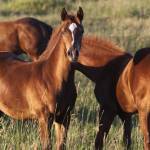Five Common Horse Pasture Pitfalls

Most horse owners, regardless of geographical location, are constrained by quadrant quandaries and are perpetually pondering posts, pickets, and planks for sanctioning steads. Large or small, all horse farms should optimize both forage growth and grazing management.
“Regardless of acreage, it is possible for any farm to sustain horses on pasture, but landowners must avoid common management pitfalls,” says Kathleen Crandell, Ph.D., equine nutritionist at Kentucky Equine Research (KER).Here are some of the most common missteps of pasture management:
1. Overgrazing and weed infestation. “An overgrazed pasture—by one horse or many—can result in the decimation of legumes and grass, allowing weeds to grow in their stead. Some invading weeds are normally avoided by horses, but when faced with no other option will be consumed and are potentially toxic,” notes Crandell.
To avoid overgrazing, consider the options:
- Implement rotational grazing, which is the division of a large grazing area into smaller plots using temporary fencing or electric tape. Sections are then grazed in sequence, which allows time for other sections to rebound.
- Limit time in pastures or use grazing muzzles when necessary to encourage pastures to grow.
- Use a sacrifice area or a drylot, where horses can still be turned out but not on the grazing areas.
- Plant various types of compatible grasses or legumes to maximize forage production.
2. Sand colic. If using sand lots or a sandy sacrifice area, consider methods that might help prevent colic due to excessive sand ingestion, such as feeding hay in nets or feeders that are off the ground or providing psyllium either with or without magnesium sulfate.
3. Parasite overload. Although horses usually defecate in one specific area of their paddock or pasture, when forage is scarce they are more likely to graze closer to manure. This could increase parasite loads as many internal parasites are transmitted via the fecal-oral route. Consider fecal egg counts, targeted deworming strategies, and appropriate pasture manure management.
4. Controlled grazing for metabolic horses. Horses with certain metabolic conditions, such as Cushing’s disease, insulin resistance, and equine metabolic syndrome, have a high risk of developing laminitis. Managing these horses on pasture can be challenging, but one important factor to consider is sugar content (fructan) in pasture grasses. Limiting turnout is one management step that might prove essential for the health of these horses.
5. Excessive body condition. “Maintaining horses on pasture 24/7 can be like an all-you-can-eat buffet, especially when grass growth is steady and stocking rate low. Be certain to critically assess the body condition of all horses to ensure they do not become obese, and to keep the obese ones from dominating grazing areas,” advises Crandell.








